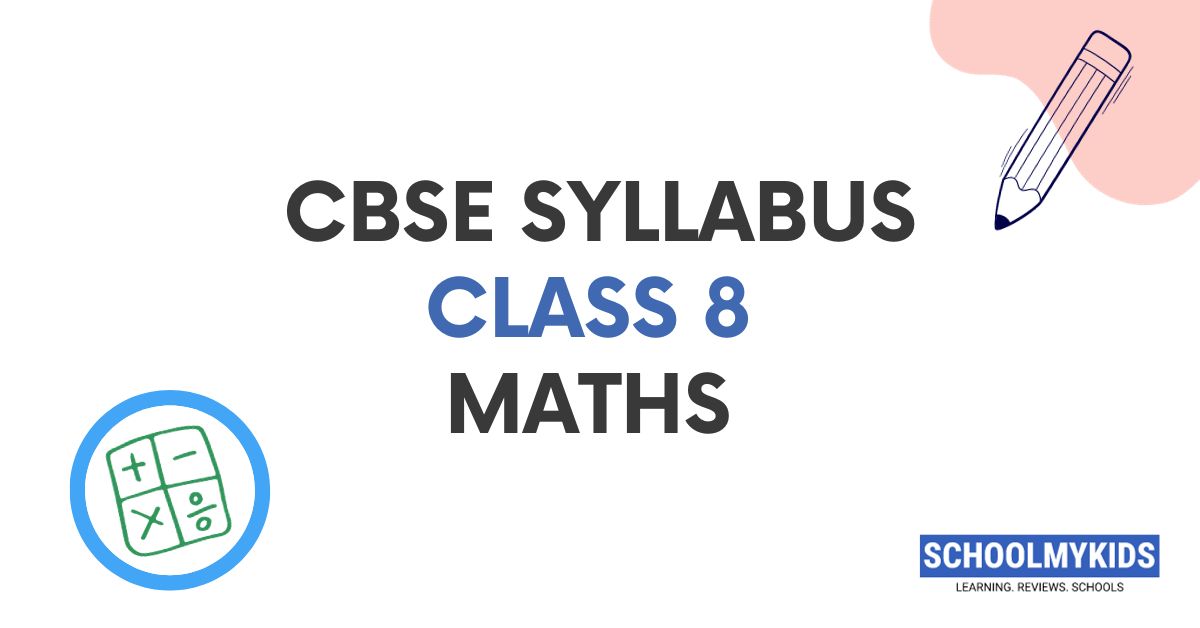The Central Board of Secondary Education (CBSE) designed the Class 8 Maths Syllabus to provide students with a comprehensive understanding of mathematics concepts. The syllabus is divided into different chapters, each covering different topics. Here is a detailed overview of the CBSE Class 8 Maths Syllabus.
Class 8 Maths Syllabus Full Syllabus
| Chapter 1: Rational Numbers | 1.1 Introduction 1.2 Properties of Rational Numbers 1.3 Representation of Rational Numbers on the Number Line 1.4 Rational Number between Two Rational Numbers |
| Chapter 2: Linear Equations in One Variable | 2.1 Introduction 2.2 Solving Equations which have Linear Expressions on one Side and Numbers on the other Side 2.3 Some Applications 2.4 Solving Equations having the Variable on both sides 2.5 Some More Applications 2.6 Reducing Equations to Simpler Form 2.7 Equations Reducible to the Linear Form |
| Chapter 3: Understanding Quadrilaterals | 3.1 Introduction 3.2 Polygons 3.3 Some of the Measures of the Exterior Angles of a Polygon 3.4 Kinds of Quadrilaterals 3.5 Some Special Parallelograms |
| Chapter 4: Practical Geometry | 4.1 Introduction 4.2 Constructing a Quadrilateral 4.3 Some Special Cases |
| Chapter 5: Data Handling | 5.1 Looking for Information 5.2 Organising Data 5.3 Grouping Data 5.4 Circle Graph or Pie Chart 5.5 Chance and Probability |
| Chapter 6: Squares and Square Roots | 6.1 Introduction 6.2 Properties of Square Numbers 6.3 Some More Interesting Patterns 6.4 Finding the Square of a Number 6.5 Square Roots 6.6 Square Roots of Decimals 6.7 Estimating Square Root |
| Chapter 7: Cubes and Cube Roots | 7.1 Introduction 7.2 Cubes 7.3 Cubes Roots |
| Chapter 8: Comparing Quantities | 8.1 Recalling Ratios and Percentages 8.2 Finding the Increase and Decrease Percent 8.3 Finding Discounts 8.4 Prices Related to Buying and Selling (Profit and Loss) 8.5 Sales Tax/Value Added Tax/Goods and Services Tax 8.6 Compound Interest 8.7 Deducing a Formula for Compound Interest 8.8 Rate Compounded Annually or Half Yearly (Semi Annually) 8.9 Applications of Compound Interest Formula |
| Chapter 9: Algebraic Expressions and Identities | 9.1 What are Expressions? 9.2 Terms, Factors and Coefficients 9.3 Monomials, Binomials and Polynomials 9.4 Like and Unlike Terms 9.5 Addition and Subtraction of Algebraic Expressions 9.6 Multiplication of Algebraic Expressions: Introduction 9.7 Multiplying a Monomial by a Monomial 9.8 Multiplying a Monomial by a Polynomial 9.9 Multiplying a Polynomial by a Polynomial 9.10 What is an Identity? 9.11 Standard Identities 9.12 Applying Identities |
| Chapter 10: Visualising Solid Shapes | 10.1 Introduction 10.2 View of 3D-Shapes 10.3 Mapping Space Around Us 10.4 Faces, Edges and Vertices |
| Chapter 11: Mensuration | 11.1 Introduction 11.2 Let us Recall 11.3 Area of Trapezium 11.4 Area of General Quadrilateral 11.5 Area of Polygons 11.6 Solid Shapes 11.7 Surface Area of Cube, Cuboid and Cylinder 11.8 Volume of Cube, Cuboid and Cylinder 11.9 Volume and Capacity |
| Chapter 12: Exponents and Powers | 12.1 Introduction 12.2 Powers with Negative Exponents 12.3 Laws of Exponents 12.4 Use of Exponents to Express Small Numbers in Standard Form |
| Chapter 13: Direct and Inverse Proportions | 13.1 Introduction 13.2 Direct Proportion 13.3 Inverse Proportion |
| Chapter 14: Factorisation | 14.1 Introduction 14.2 What is Factorisation? 14.3 Division of Algebraic Expressions 14.4 Division of Algebraic Expressions Continued (Polynomial / Polynomial) 14.5 Can you Find the Error? |
| Chapter 15: Introduction to Graphs | 15.1 Introduction15.2 Linear Graphs 15.3 Some Applications |
| Chapter 16: Playing with Numbers | 16.1 Introduction 16.2 Numbers in General Form 16.3 Game with Numbers 16.4 Letters for Digits 16.5 Test of Divisibility |
Class 8 Maths Syllabus Chapter Wise Overview
Chapter 1: Rational Numbers
This chapter covers the definition and properties of rational numbers, their representation on a number line, and the conversion of recurring decimals to fractions.
Chapter 2: Linear Equations in One Variable
In this chapter, students learn about linear equations, their solutions, and how to solve them using different methods.
Chapter 3: Understanding Quadrilaterals
This chapter teaches students about different types of quadrilaterals, their properties, and how to calculate their angles and diagonals.
Chapter 4: Practical Geometry
In this chapter, students learn how to construct different types of geometrical shapes and figures using a ruler, compass, and protractor.
Chapter 5: Data Handling
This chapter covers the collection, organisation, and representation of data in different forms, including tables, graphs, and charts.
Chapter 6: Squares and Square Roots
Here, students learn about the properties of squares and square roots, their calculation, and how to use them in solving problems.
Chapter 7: Cubes and Cube Roots
This chapter covers the definition and properties of cubes and cube roots, their calculation, and how to use them in problem-solving.
Chapter 8: Comparing Quantities
In this chapter, students learn how to compare quantities and calculate discounts, profit and loss, and sales tax.
Chapter 9: Algebraic Expressions and Identities
This chapter covers the definition and properties of algebraic expressions, their simplification, and how to use them in solving problems.
Chapter 10: Visualising Solid Shapes
Here, students learn about different types of solid shapes, their properties, and how to calculate their surface area and volume.
Chapter 11: Mensuration
This chapter covers the calculation of the perimeter, area, and volume of different types of geometrical shapes and figures.
Chapter 12: Exponents and Powers
In this chapter, students learn about the properties of exponents and powers, their calculation, and how to use them in problem-solving.
Chapter 13: Direct and Inverse Proportions
Here, students learn about direct and inverse proportions and how to solve problems related to them.
Chapter 14: Factorization
This chapter covers the factorization of algebraic expressions and how to use it in problem-solving.
Chapter 15: Introduction to Graphs
In this chapter, students learn about different types of graphs and how to represent data using them.
Chapter 16: Playing with Numbers
In this chapter, students learn about different number games and tricks. These games and tricks can help students develop their mental maths skills and make maths more enjoyable. Some of the topics covered in this section include finding the missing number in a series, divisibility tests, and magic squares.
Conclusion
The CBSE Class 8 Maths Syllabus covers a wide range of topics, aimed at providing students with a solid foundation in mathematics. The syllabus is designed to be comprehensive, covering all the essential concepts in detail. By understanding and mastering the topics covered in this syllabus, students can develop a strong foundation in mathematics, which can help them excel in higher classes and in their future careers.









Be the first one to comment on this story.